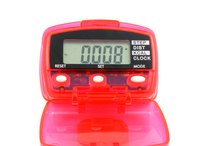Weight Watchers Maintenance
**Weight Watchers uses its patented points system to help you reach and maintain your goal weight 1.
** Upon starting the weight loss program, your points target is designed to help you lose weight at a healthy rate of 1 to 2 lbs. weekly. The maintenance phase adjusts that target to help you stay at or near goal weight 1.
Identification
To reach your goal weight, you determine how many points you are allowed daily using the Weight Watchers points quiz. Once you reach your goal, your points allowance increases so that you no longer lose weight.
For maintenance, start by adding 4 points to your daily target. If you gain, adjust your points target down by 2. If you lose weight, add 2 points.
Your optimum maintenance points target is one that helps you stay within 2 lbs. of your goal weight for three consecutive weeks, according to Weight Watchers.
- To reach your goal weight, you determine how many points you are allowed daily using the Weight Watchers points quiz.
Significance
How Many Points a Day for Weight Watchers?
Learn More
The purpose of the Weight Watchers Maintenance phase is to help you maintain your weight once you reach your weight goal [1](https://www.weightwatchers.com/help/index.aspx?pageid=1035871 'inline-reference::Weight Watchers: What Do I Need to Do to Reach the Phase of the Plan Called Maintenance?
')2.
During the maintenance phase, you make adjustments to find an appropriate points target for weight maintenance and continue your regular weigh-ins. ** The maintenance phase lasts at least six weeks, or until your weight levels out at no more than 2 lbs. under or over your goal weight.
- The purpose of the Weight Watchers Maintenance phase is to help you maintain your weight once you reach your weight goal 1
Features
The weekly allowance of 35 additional points that you can use any time during the weight loss phase of Weight Watchers is also part of the maintenance phase [1](https://www.weightwatchers.com/help/index.aspx?pageid=1035871 'inline-reference::Weight Watchers: What Do I Need to Do to Reach the Phase of the Plan Called Maintenance?
')2. The 35 points allowance renews weekly during the maintenance phase and can be used in any increments at any time or not used at all. Continue your exercise routine during the maintenance phase. Part of the Weight Watchers philosophy is to encourage long-term healthy eating and exercise habits 2.
Benefits
Weight Watchers Points for a Pineapple
Learn More
Successfully completing the maintenance phase qualifies Weight Watchers Meetings members for lifetime membership status, according to Weight Watchers 12. To qualify, your maintenance weight must be within the Weight Watchers healthy weight range based on body mass index 1. Additionally, you must weigh in within 2 lbs. of your goal weight at least twice between making your goal and your final maintenance weigh-in. As a lifetime member, you can attend meetings anywhere, free of charge, as long you stay within 2 lbs. of your weight goal 1. Lifetime members who reach and maintain a goal weight within Weight Watchers healthy weight range are eligible to seek employment with Weight Watchers 2.
Considerations
The six weeks of maintenance is intended to teach you how to stay at or near your weight goal after the maintenance period 1.
To maintain your weight long term, continue to eat within your maintenance points target and exercise regularly. Weigh in at least monthly to help you stay on track. If you gain weight, lower your points target until you reach your weight goal and go back into the maintenance phase 1. **
- The six weeks of maintenance is intended to teach you how to stay at or near your weight goal after the maintenance period 1.
Related Articles
References
- Weight Watchers: What Do I Need to Do to Reach the Phase of the Plan Called Maintenance?
- Weight Watchers: What Is a Lifetime Member?
- Ahern AL, Wheeler GM, Aveyard P, et al. Extended and standard duration weight-loss programme referrals for adults in primary care (WRAP): a randomised controlled trial [published correction appears in Lancet. 2017 Jun 3;389(10085):2192]. Lancet. 2017;389(10085):2214–2225. doi:10.1016/S0140-6736(17)30647-5
- Gudzune KA, Doshi RS, Mehta AK, et al. Efficacy of commercial weight-loss programs: an updated systematic review [published correction appears in Ann Intern Med. 2015 May 19;162(10):739-40]. Ann Intern Med. 2015;162(7):501–512. doi:10.7326/M14-2238
- Gorin AA, Lenz EM, Cornelius T, Huedo-Medina T, Wojtanowski AC, Foster GD. Randomized Controlled Trial Examining the Ripple Effect of a Nationally Available Weight Management Program on Untreated Spouses. Obesity (Silver Spring). 2018;26(3):499–504. doi:10.1002/oby.22098
- Piper C, Marossy A, Griffiths Z, Adegboye A. Evaluation of a type 2 diabetes prevention program using a commercial weight management provider for non-diabetic hyperglycemic patients referred by primary care in the UK. BMJ Open Diabetes Res Care. 2017;5(1):e000418. Published 2017 Oct 16. doi:10.1136/bmjdrc-2017-000418
- Piper C, Marossy A, Griffiths Z, Adegboye A. Evaluation of a type 2 diabetes prevention program using a commercial weight management provider for non-diabetic hyperglycemic patients referred by primary care in the UK. BMJ Open Diabetes Res Care. 2017;5(1):e000418. Published 2017 Oct 16. doi:10.1136/bmjdrc-2017-000418
- O’Neil et al. Randomized controlled trial of a nationally available weight control program tailored for adults with type 2 diabetes. Obesity (Silver Spring). 2016 Nov;24(11):2269-2277.
- Mehta AK, Doshi RS, Chaudhry ZW, et al. Benefits of commercial weight-loss programs on blood pressure and lipids: a systematic review. Prev Med. 2016;90:86–99. doi:10.1016/j.ypmed.2016.06.028
Resources
Writer Bio
Pam Murphy is a writer specializing in fitness, childcare and business-related topics. She is a member of the National Association for Family Child Care and contributes to various websites. Murphy is a licensed childcare professional and holds a Bachelor of Arts in English from the University of West Georgia.








